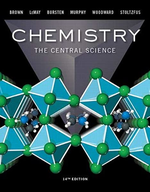?Antibonding molecular orbitals can be used to make bonds to other atoms in a molecule
Chapter 9, Problem 9.121(choose chapter or problem)
Antibonding molecular orbitals can be used to make bonds to other atoms in a molecule. For example, metal atoms can use appropriate d orbitals to overlap with the \(\pi_{2 p}^{*}\) orbitals of the carbon monoxide molecule. This is called d-\(\pi\) backbonding.
(a) Draw a coordinate axis system in which the y-axis is vertical in the plane of the paper and the x-axis horizontal. Write “M” at the origin to denote a metal atom.
(b) Now, on the x-axis to the right of M, draw the Lewis structure of a CO molecule, with the carbon nearest the M. The CO bond axis should be on the x-axis.
(c) Draw the CO \(\pi_{2 p}^{*}\) orbital, with phases (see the “Closer Look” box on phases) in the plane of the paper. Two lobes should be pointing toward M.
(d) Now draw the dxy orbital of M, with phases. Can you see how they will overlap with the \(\pi_{2 p}^{*}\) orbital of CO?
(e) What kind of bond is being made with the orbitals between M and C, \(\sigma\) or \(\pi\) ?
(f) Predict what will happen to the strength of the CO bond in a metal–CO complex compared to CO alone.
Text Transcription:
pi_2p^*
pi
sigma
Unfortunately, we don't have that question answered yet. But you can get it answered in just 5 hours by Logging in or Becoming a subscriber.
Becoming a subscriber
Or look for another answer
